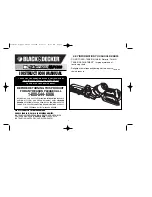
19
.
Fence
Blade Guard
Riving
Knife
Pawl Assy
Miter Gauge
Blade Wrench
PUSH STICK
Always using push sticks Fig. 19 that reduce the
risk of injury by keeping your hands away from
the blade while cutting. Whenever your hands
will get within 12" of the blade.
To maintain control when cutting large
workpieces, start the cut by feeding with your
hands then use push sticks to finish the cut, so
your hands are not on the end of the workpiece
as it passes through the blade.
MITER GAUGE
The miter gauge is equipped with stop screws
that allow you to easily adjust the miter gauge
from 45° to the left, 90° and 45° to the right the
stop screws contact the shaft Fig. 20, which
moves in or out of the way for adjustments slide
the miter gauge into the t-slot on the table, then
push the sliding shaft all the way into the miter
gauge.
To use a setting other than 90°, loosen the lock
knob B by turning it counter-clockwise, pull the
stop-lock pin C Fig. 21rotate the miter head to
45°, or any angle shown on the numerical guide.
Turn the lock knob clockwise to tighten it.
To check the accuracy of the miter gauge’s
factory set- tings, set it at 90° and check it with
an L-square or T-square. To verify the setting,
make a test cut in scrap stock and then use a
square to check the cut piece.
Repeat adjustment if necessary.
If the miter gauge needs adjusting, manually
turn the head so the pointer is where you think it
ought to be, tighten the lock knob and loosen
the nut
STORAGE BOX
There is a storage box on the cabinet for user to
leave with all of accessories on the saw.
Fig. 18
Fig. 19
Fig. 20
Fig. 21
B
C
















































